We may have been glad to see the back of January, but it certainly wasn’t all blue. The first month of the year brought excitement to the wine world with Domaine de la Romanée-Conti’s (DRC) 2015 release, and to Wine Lister with our first ever 1000-point Brand score. For much of London’s bustling City, the end of February means one thing: bonus time. The Financial Times’ February edition of How To Spend It already features the iconic DRC – below are some further ideas for wines to blow the budget.
Prices from our data partner, Wine Owners, are shown ex duty and sales tax (VAT) per bottle as averages across Wine Lister featured vintages.
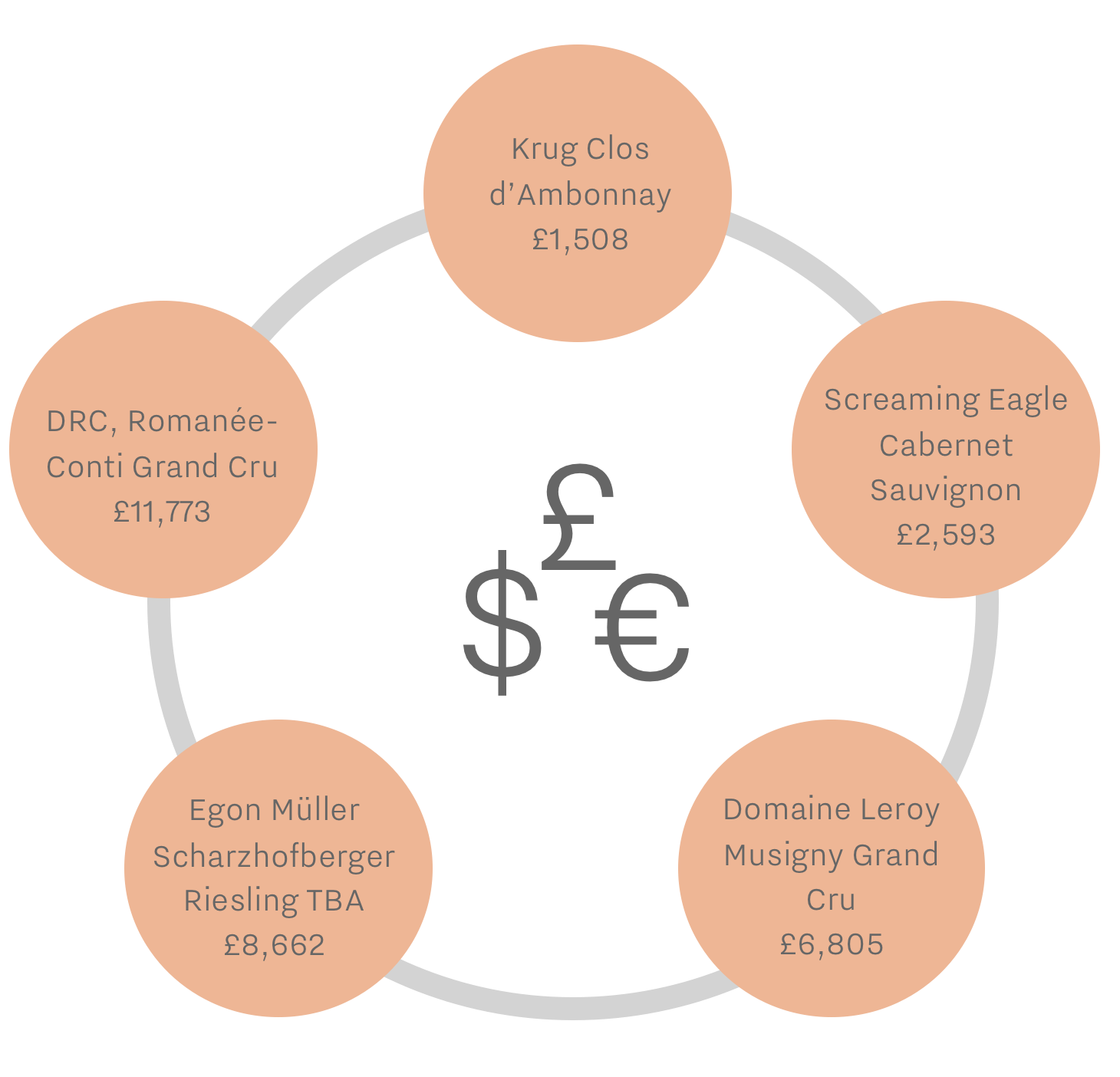
- Krug Clos d’Ambonnay
While Dom Pérignon or Louis Roederer’s Cristal are more commonly associated with City celebrations, those in the know will be toasting with Krug’s famous Pinot Noir expression. With an average Quality score of 969 and a price of £1,367 per bottle for the latest available vintage (2000), a glass of Krug Clos d’Ambonnay is, in itself, cause for celebration.
- Screaming Eagle Cabernet Sauvignon
If you’re one of the lucky few on Screaming Eagle’s direct mailing list, congratulations. It is one of the most talked-about wines by the trade based on the results of Wine Lister’s proprietary Founding Member survey, and counts over 17,000 monthly online searches on Wine-Searcher. The average £2,593 price tag per bottle is therefore a small price to pay, if indeed you are able to get your hands on one of the 7,800 bottles produced each year.
- Egon Müller Scharzhofberger Riesling TBA
Even harder to find is Egon Müller’s Scharzhofberger Riesling TBA. It breaks a number of records, including Wine Lister’s rarest wine (with an average of only 150 bottles produced per annum) and the highest ever average Wine Lister Quality score (995). Prices range from £5,848 per bottle to over £21,000 per bottle for older vintages.
- Domaine Leroy Musigny Grand Cru
The second most expensive of all French wines, let alone in Burgundy, is Domaine Leroy’s Musigny. At just over half the price of DRC Romanée-Conti, averaging £6,805 per bottle, its consistent quality is matched by impressive price growth, with a compound average growth rate of 26%. It featured in last year’s Listed blog, “the best wines money can buy”, which certainly still rings true.
For some, Piedmont is virtually synonymous with the DOCG appellation of Barolo. While wines from this famous appellation rank amongst the very best on Wine Lister, its understated sibling Barbaresco also holds its own, as we discover looking at the top five Barbarescos by Wine Lister score below.
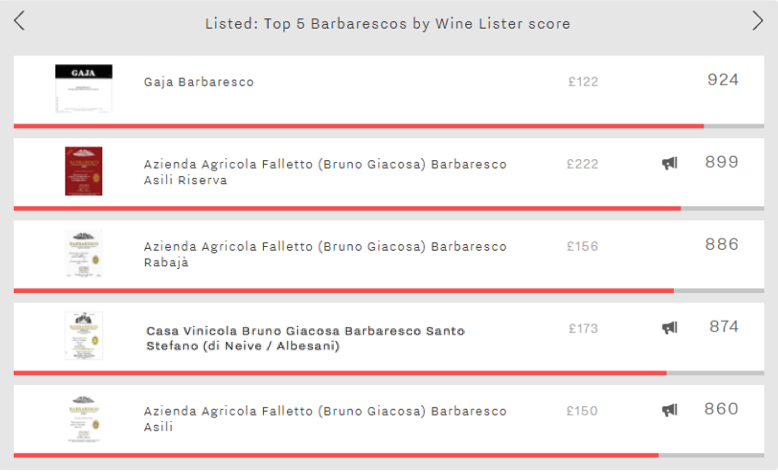
With an overall score of 924, Gaja’s Barbaresco takes the top spot. It leads thanks to its excellent Brand score (977), over 120 points ahead of Barbaresco’s second-strongest brand. As the only one of the group with brand as its strongest suit, Gaja’s Barbaresco is present in 33% of the world’s top restaurants, has the widest range of vintages and formats on each wine list, and receives over five times more searches each month on Wine-Searcher than the second-most popular wine of the group. Consequently, the wine has the joint-highest Brand score of all Piedmont wines – alongside Giacomo Conterno’s Barolo Monfortino Riserva.
Numbers two to five on the list share the same legendary producer. The recently departed Bruno Giacosa has left behind him a formidable legacy, reflected in his four-fold appearance in this top five. The domaine Azienda Agricola Falleto’s and Giacosa’s negotiant arm expressions of Barbaresco excel across all three categories that make up their overall Wine Lister score.
Azienda Agricola Falletto’s Asili Riserva has the best Economics score of all Barbarescos (967), with a compound annual growth rate (CAGR) of 18.5%. It is also the most expensive at £222 per bottle, and most traded of the five.
Giacosa’s Barbaresco Rabajà takes third place, but holds the best Quality score (963) and best long-term price performance (27.0%). The former is reflected in the wine’s impressive average ageing potential of 22 years, five years longer than the Asili Riserva. Indeed, Rabajà 2004, which achieves an outstanding Quality score of 993, has only recently entered its drinking window, and will be drinking well until 2034.
Fourth and fifth spots are taken by Giacosa’s Barbaresco Santo Stefano (di Nieve / Albesani) and Barbaresco Asili. They display very similar profiles, each performing best in the Economics category, followed by Quality, and then Brand. Both wines still rank as “very strong” on the Wine Lister 1000-point scale, with overall scores of 874 and 860 respectively.
This is a poignant week for Azienda Agricola Falletto, with many of the great estate’s wines being released for the first time since the passing of Bruno Giacosa.
Last week we were lucky enough to taste through the 2008 vintage of Bordeaux grands crus classés at BI Fine Wines’ 10 years on tasting. Below we explore what light Wine Lister scores have to shed on the quality and price performance of different appellations in 2008.
Wine Lister’s holistic and dynamic approach allows us to not only see which appellations produced the vintage’s best wines, but also demonstrates if and how the market has since reacted to each appellation’s relative quality.
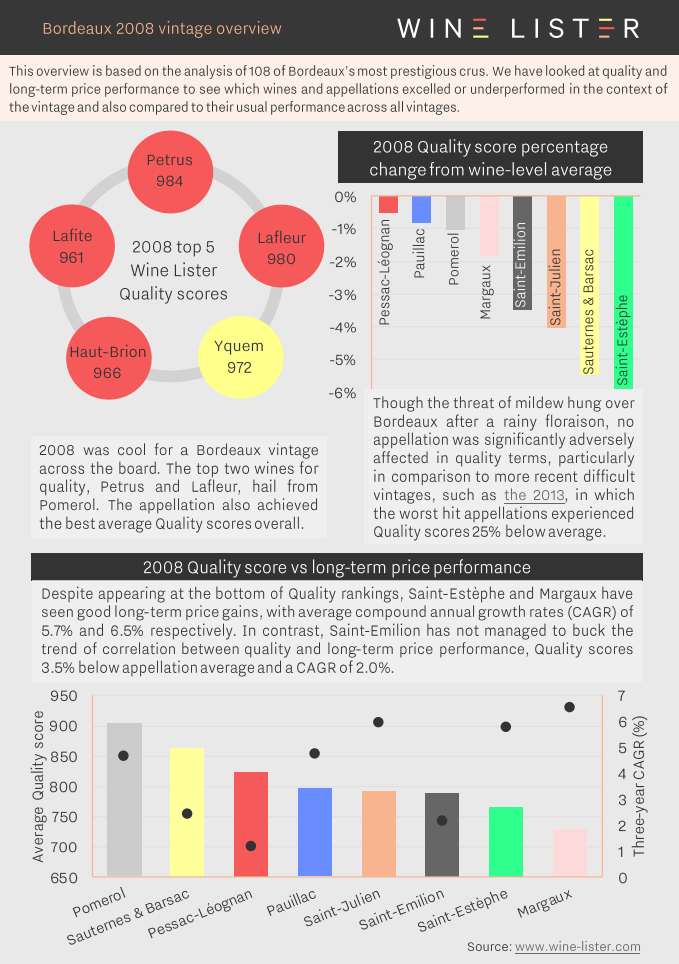
You can download the slide here: Wine Lister Bordeaux 2008 vintage overview
Featured wines: Petrus, Lafleur, Yquem, Haut-Brion, Lafite
Today marks the close of a busy week of Burgundy 2016 en primeur tastings, with offer prices largely stable on 2015 despite tiny volumes, thanks to the more generous 2017 in the wings. However, prices have been escalating in the secondary market for several years now, with eight of the region’s top wines averaging more than £3,000 per bottle). Eyewatering, yes, but as illustrated in our recently published study, the majority of the region’s top wines are priced between £100 and £500.
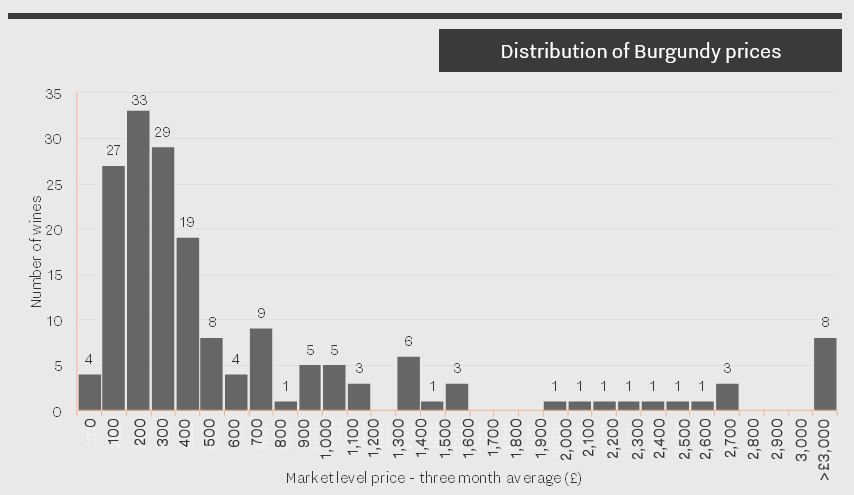
To mark this week’s Burgundy en primeur tastings, the latest Listed section picks out the top five red Burgundies priced under £300 per bottle by Wine Lister score. With an outstanding average score of 913 – putting them amongst the very strongest on Wine Lister – and four of the five achieving Buzz Brand status, these wines are worth the price tag.
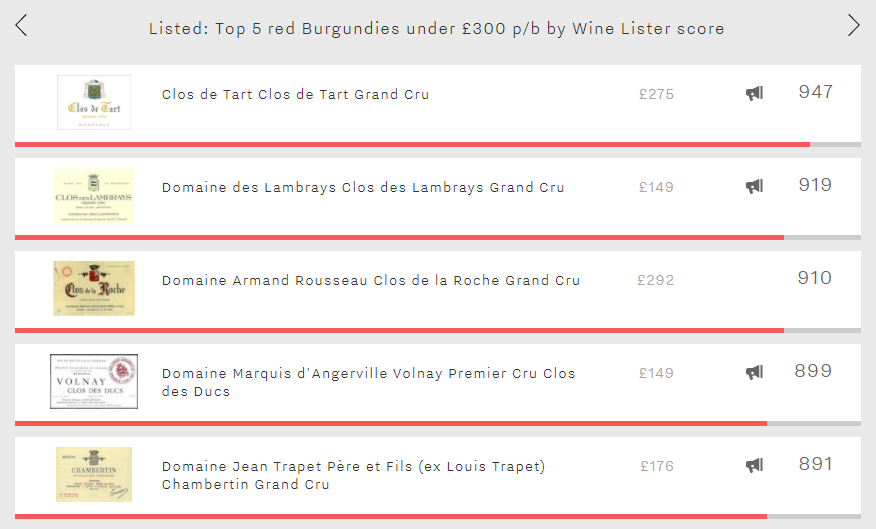
Leading the way is Grand Cru monopole Clos de Tart with a score of 947. Recently acquired by Artemis Domaines – Latour owner François Pinault’s holding company – it achieves the best Brand and Economics scores of the group (956 and 964 respectively), and is just pipped into second place in the Quality category by Trapet Père et Fils Chambertin Grand Cru (932 vs 940). Its price has increased 9% over the past six months, and now at £275, it looks like it won’t qualify for this group much longer!
Next comes Domaine des Lambrays Clos des Lambrays – part of LVMH’s portfolio since 2014 – with a score of 919. Alongside Marquis d’Angerville Volnay Premier Cru Clos des Ducs, this is the cheapest (or least expensive) of the group (c.£150 each). It enjoys its best score in the Brand category, with the group’s highest level of restaurant presence (25%), and the second-best average monthly online search frequency (5,079).
In third place is Rousseau’s Clos de la Roche Grand Cru with a score of 910. At almost £300 per bottle, it is the most expensive of the group, contributing to its boasting the best score in the Economics category (937). It is also partner critic Jeannie Cho Lee’s favourite wine of the group; she awards it a score of 95/100 on average.
Dropping just below the 900-point mark are Marquis d’Angerville Volnay Premier Cru Clos des Ducs and Trapet Père et Fils Chambertin Grand Cru (899 and 891 points respectively). They display very different profiles. The latter leads the Quality category, with the former lagging 60 points behind (still with a very strong score of 879). However,Trapet’s Chambertin struggles in other categories, with the group’s lowest scores for Brand and Economics (867 and 823). Meanwhile, thanks to the group’s strongest long and short-term growth rates, Marquis d’Angerville’s Volnay Clos des Ducs enjoys an excellent Economics score (939) – the second-best of the five.
If you’d like to discover more about Burgundy and its top wines, then click here if you are a subscriber to view the full regional study, or here to see a preview if you haven’t yet subscribed.
With the Burgundy 2016 campaign underway, our first blog of the new year sheds some light on an all too often complex region. In our inaugural Burgundy study, Wine Lister reveals some key findings. Read on to find out more or click here to access the full study (non-subscribers can see a preview of the study here).
Price: the unstoppable force?
While the region’s Brand scores are no match for Bordeaux, Burgundy’s supply and demand dynamic(emphasised by a five-year stock shortage) and high quality are driving prices ever skywards. The majority of top Burgundy wines cost between £100 and £500 a bottle, with 18 wines costing more than £2000 per bottle.
Among the impressive Economics scores (994 being the highest) it is no surprise that producers such as Domaine de la Romanée-Conti (DRC) and Domaine Leroy hold many of the top spots (note that the only whites to enter into the Top 25 for Economics are from Coche-Dury). However, the region as a whole rises above the rest on price performance. Burgundy‘s prices have risen more quickly than any other top fine wine region and show no sign of decelerating.
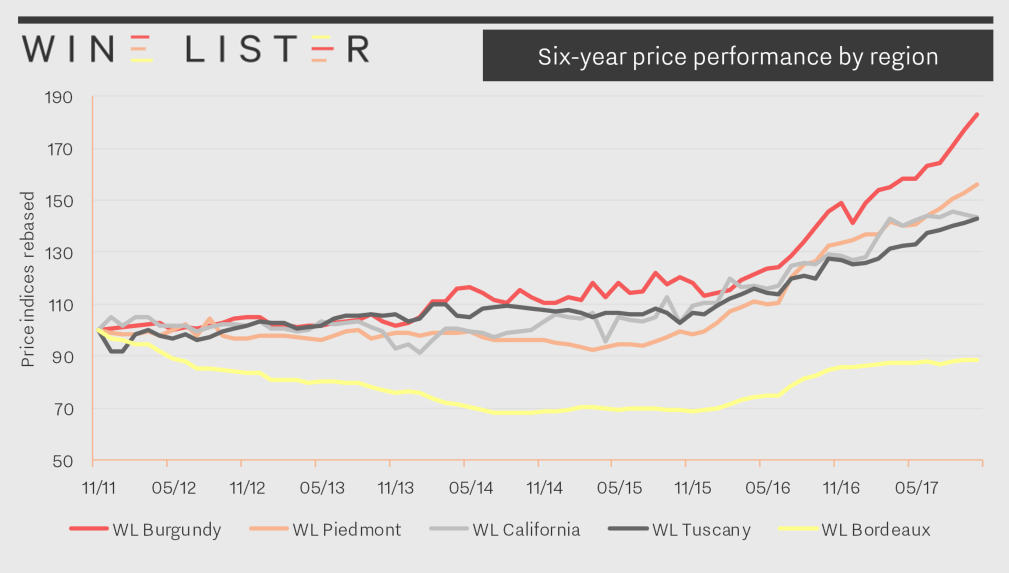
Quality: the clear winners
Indeed, DRC and Domaine Leroy consistently top the charts across all Wine Lister scores. However, Lalou Bize-Leroy is Quality queen, with 11 wines in the Quality top 25 between Leroy and d’Auvenay.
DRC and Armand Rousseau stand out as being the only two producers to gain the trade’s full confidence. Our Founding Members give the domaines a confidence rating of 10/10 (no Bordeaux chateau scores above 9/10).
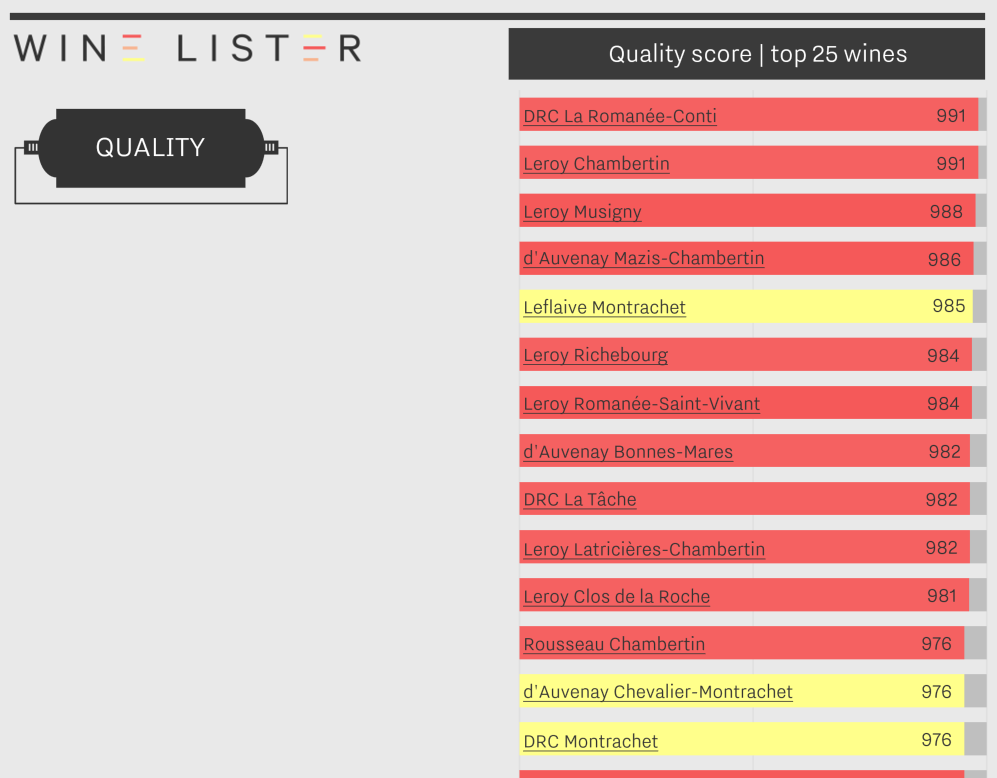
Trends: what the future holds for Burgundy
Further insight from Wine Lister’s 52 Founding Members (key global fine wine trade figures)includes growth trends for Burgundy.
One commonality throughout the trade was the noticeable rise in the popularity of Saint-Aubin (Burgundy is the region home to more “rising star” producers than any other fine wine region). Other observations included a general shift towards higher quality and greater purity in winemaking style, as well as less sulphur and more whole bunch fermentation.
Subscribers can read the full study here. Non-subscribers can access a preview of the full version or subscribe here.
If ever there was a time of year to push the boat out, then surely this is it. So this week our Listed section travels to Burgundy for Chambertin’s top five wines for Quality. All achieving a Quality score of at least 966, thus ranking amongst the very best on Wine Lister’s database, these are some of the most sought-after wines in the world.
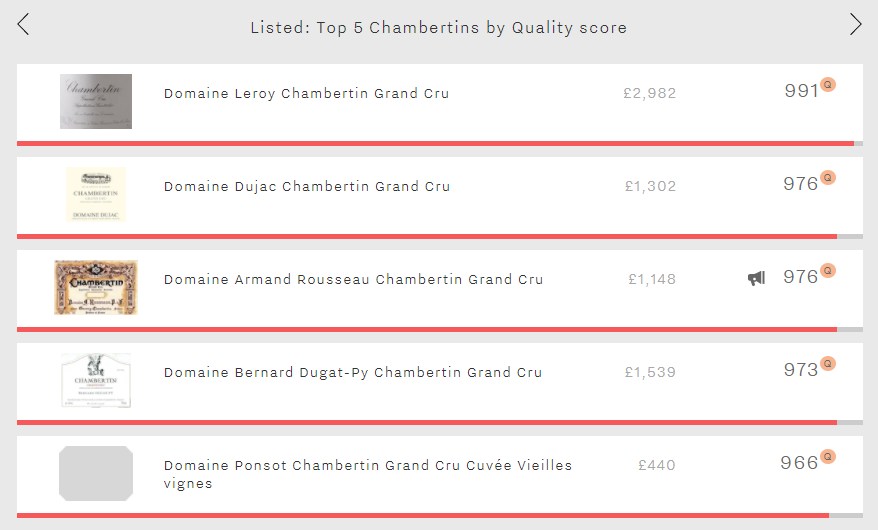
Leading the way with a score of 991 is Leroy’s offering. This exceptional score is the third-best Quality score on Wine Lister and the highest of any red wine (alongside DRC La Romanée-Conti). Across all vintages, it receives near-perfect ratings from Wine Lister partner critics Jancis Robinson and Jeannie Cho Lee (19.5/20 and 99/100 respectively). Moreover, Jeannie Cho Lee awarded a 100 point score to the 2015 vintage. But with the longest ageing potential of the group – over 18 years on average – the 2015 will reward patient drinkers, and with a wine-level average price of £2982 per bottle, you would want to savour it at its peak.
Next come Dujac and Rousseau’s offerings with scores of 976. Whilst these wines achieve identical Quality scores, and similar Economics ratings (951 and 979 respectively), the Rousseau achieves a far superior Brand score (960 vs 608). In fact Rousseau’s Chambertin convincingly outperforms the others in the Brand category, which achieve an average score of 638. The chart below confirms that Rousseau’s Chambertin enjoys far greater brand recognition than its Quality score would suggest within this set of peers, definitely earning its Buzz Brand status.
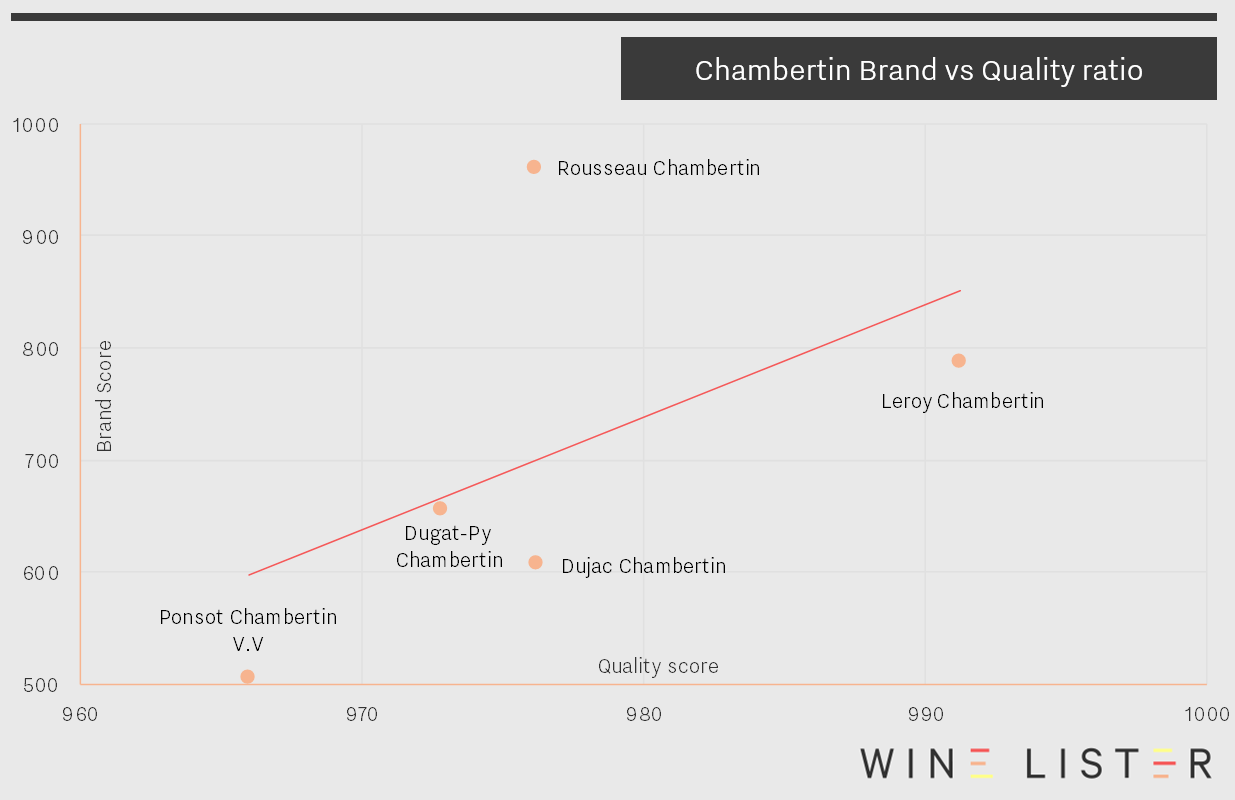
In fourth place is Dugat-Py’s Chambertin (973), just seven points ahead of Ponsot’s Chambertin Cuvée Vieilles Vignes (966). Despite their similar Quality scores, there is a noticeable difference in their prices, with the Dugat-Py the second most expensive wine in the group (£1539), whilst the Ponsot is by far the cheapest (£440) and looks relatively good value. If we look a little further, Ponsot Chambertin 2007, with a Quality score of 968 is currently available for as little as £399 per bottle and is in the middle of its drinking window, making it an excellent proposition for that seasonal treat.
If you are interested in Burgundy and its position in the fine wine market, then watch this space for our forthcoming in-depth regional study, due to be released in January.
This week, our listed section journeys to the most northerly Burgundy appellation to look at Wine Lister’s top five Chablis by Quality score. Wine Lister’s Quality score comprises the average rating of our four partner critics, as well as a wine’s ageing potential.
In fifth place is Hidden Gem, Domaine Gérard Duplessis Chablis Grand Cru Les Clos. Producing only 1,500 bottles a year, this wine is present in just 2% of the world’s top restaurants, but receives a very strong rating from Jancis Robinson, setting its Quality score at 910.
Domaine William Fèvre Chablis Grand Cru Les Clos is fourth-highest with a Quality score of 927. Whilst Jeannie Cho Lee doesn’t score the wine as highly as our other critics, at £55 it still represents a lot of bang for your buck.
Bronze goes to Domaine Raveneau Chablis Grand Cru Valmur, with a Quality score of 946. The only wine of the group not from the Les Clos climat, it has a predicted drinking window of 10 years – higher than the rest of its peer group, which averages eight years.
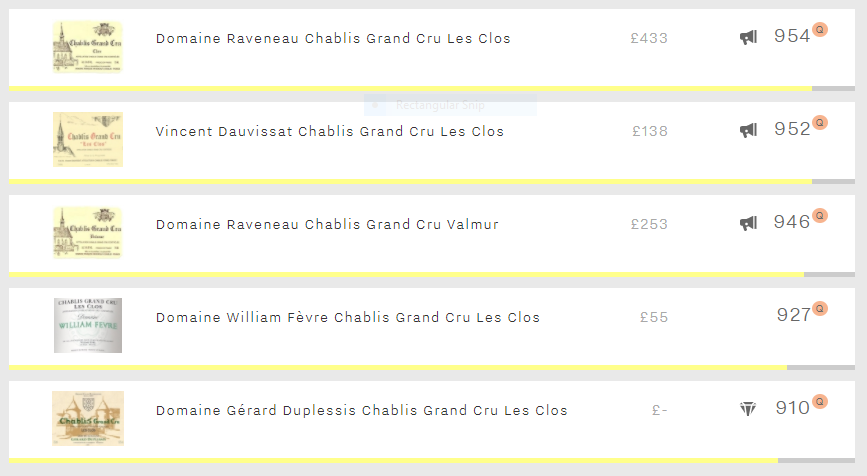
Vincent Dauvissat Chablis Grand Cru Les Clos has the second-highest Quality score (952) and also has the biggest variance in ratings from our partner critics, receiving an outstanding score from Jeannie Cho Lee, but a far more modest one from UK critic Jancis Robinson.
Winning the Quality score crown by a narrow two-point difference (954) is the second wine of the group from Raveneau – the domaine’s Les Clos offering. Enjoying uniformly excellent scores from each of our partner critics, it’s one of the most talked-about wines in the fine wine trade and unsurprisingly holds Wine Lister Buzz Brand status.
For this week’s top five, the spotlight is on our highest ranked Spanish red wines. All achieve a total Wine Lister score of over 913, yet there is a significant price difference between the lowest and highest priced bottle (over £500).
Vega-Sicilia Unico wins the Spanish sprint to the top spot with an applaudable Wine Lister score of 971. With impressive restaurant presence (47%) and over 17,000 average monthly searches, the wine’s Brand score is a big contributor to its number one spot.
Next, scoring 47 points less (923) though more than double the price (£573), is Pingus. With consistently high ratings from Jancis Robinson, Jeannie Cho Lee and Antonio Galloni, it has a very strong Quality score of 936 – identical to its Brand score.
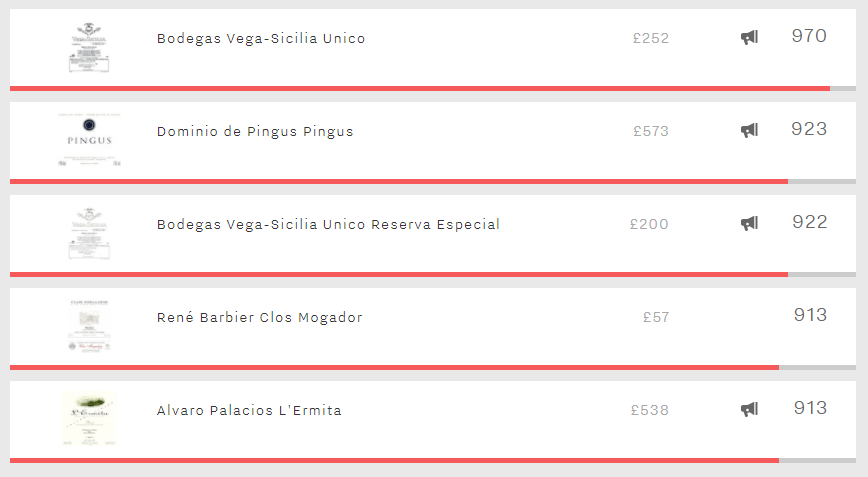
A second wine from Spain’s most prestigious wine estate, the Vega-Sicilia Unico Reserva Especial, comes in third place with the highest Quality score of the group (983). However, similar to all the other top five’s, its price has been decreasing since August.
The most affordable wine of the group is the René Barbier Clos Mogador, at £57 per bottle on average. It’s the only wine of the five not to hold Buzz Brand status, though it scores five out of five for liquidity, with 300 bottles of its top five vintages traded in the past year.
Joint fourth is Alvaro Palacios L’Ermita, matching Clos Mogador’s Wine Lister score of 913. Its three-month average price scores four out of five — an improvement on its six-month price performance of two out of five. It’s the rarest in its peer group, producing just 1,350 bottles per year on average, though it still manages to achieve 19% restaurant presence.
With the recent addition of Jeannie Cho Lee MW as Wine Lister’s fourth partner critic, now seems a good opportunity to elucidate our approach to calculating Quality scores.
Wine Lister’s Quality scoring algorithm takes into account each critic’s rating scale and the relative generosity or severity of their scoring.
Vinous and Jeannie Cho Lee rate on a 100-point scale, whereas Jancis Robinson and Bettane+Desseauve rate on a 20-point scale. But we also know that the former pair never (or very rarely) give a rating less than 70, while the latter never (or very rarely) give a rating less than 10.
The first step in our scoring algorithm is to put all ratings on a level playing field by rebasing them. We take each critic’s minimum and maximum wine ratings and spread these back out over our entire 100-point scale. The result is that, for example, a Bettane+Desseauve rating of 15 and a Jeannie Cho Lee rating of 85 both score 50 out of 100.
But it’s not quite that simple! We also know that the way the critics score is different. For example, we find that Jeannie Cho Lee tends to give fewer high scores than Vinous. Our algorithm takes into consideration these tendencies towards more or less generous ratings, and adjusts scores as necessary for a fair outcome. This is our score normalisation process.
Using nonparametric statistical techniques, for the same wine-vintages that the critics have rated, we look at each critic’s probability of awarding each score, and use the difference in probabilities to make necessary adjustments.
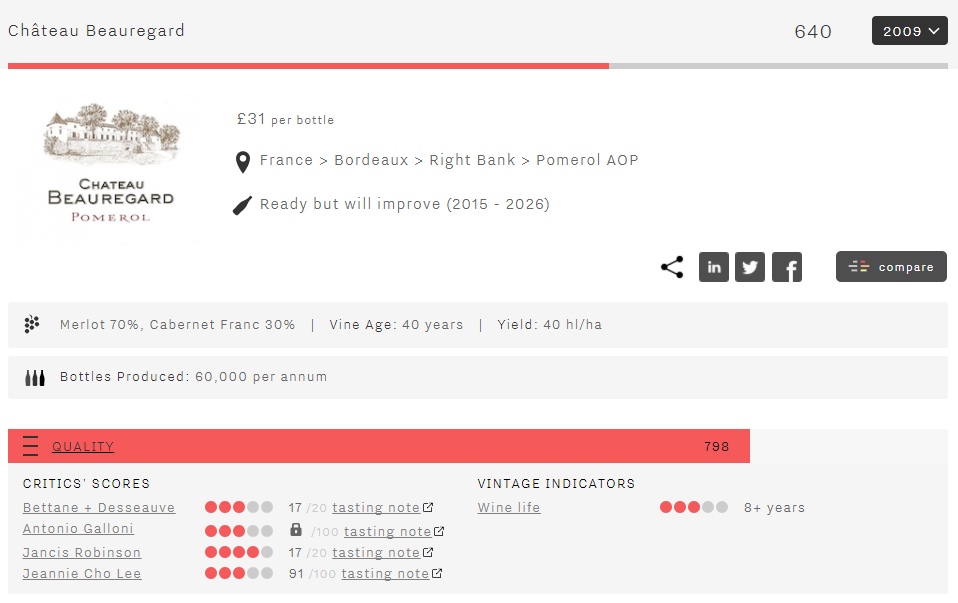
For example, we looked at the set of wine-vintages rated by both Jancis Robinson and Bettane+Desseauve, and found that wines are around 5% more likely to achieve a rating of 17 or higher from Bettane+Desseauve. Once normalised, this means that a wine such as Château Beauregard 2009, rated 17 by both Bettane+Desseauve and Jancis Robinson, achieves Wine Lister critic scores of 73 and 76 respectively. In other words, 17 is harder to get from Jancis Robinson than from Bettane+Desseauve. This is illustrated in the image above.
Once we’ve rebased and normalised the critics’ scores, we simply take an average of those scores, giving an equal rating to each of our four partner critics, each of whom represents one of the world’s key fine wine markets.
There’s still more… The Wine Lister Quality score also takes into consideration a wine’s ageing potential as defined by critics’ drinking windows – watch this space for a further explanation of how that works!
We are thrilled to announce the addition of Jeannie Cho Lee MW as Wine Lister’s fourth partner critic, representing the Asian market.
Wine Lister gathers data from multiple sources to assess thousands of wines on a truly holistic basis. Scores are made up of three main categories: Quality, Brand, and Economics. Critic ratings form a vital part of the Quality category, providing reliable scores and drinking window information.
Jeannie Cho Lee is an independent wine critic, a university professor, and an award-winning author who in 2008 was the first Asian to become a Master of Wine. Based in Hong Kong, she writes about wine on her website, www.jeanniecholee.com, and has also published several books, including Asian Palate.
Adding to our unique collaborations with three of the most reputable wine critics in the world’s major fine wine markets – Jancis Robinson (UK), Antonio Galloni (Vinous) (USA), and Bettane+Desseauve (France) – we are delighted to welcome Jeannie Cho Lee to represent the key Asian fine wine market. This careful addition will help us in our goal of providing ever more reliable and accurate ratings and analysis, while crucially maintaining the high standards of this elite pool of critics. Jeannie Cho Lee’s scores have been added to those of our existing partner critics, and fed into Wine Lister’s bespoke algorithm to produce a Quality score out of 1,000 points. Wine Lister takes each critic’s minimum and maximum wine ratings and spreads these back out over the entire scale. As each wine critic scores differently (not just on a different scale), we also account for the frequency of ratings and normalise scores for fair comparison. Each critic is weighted equally.
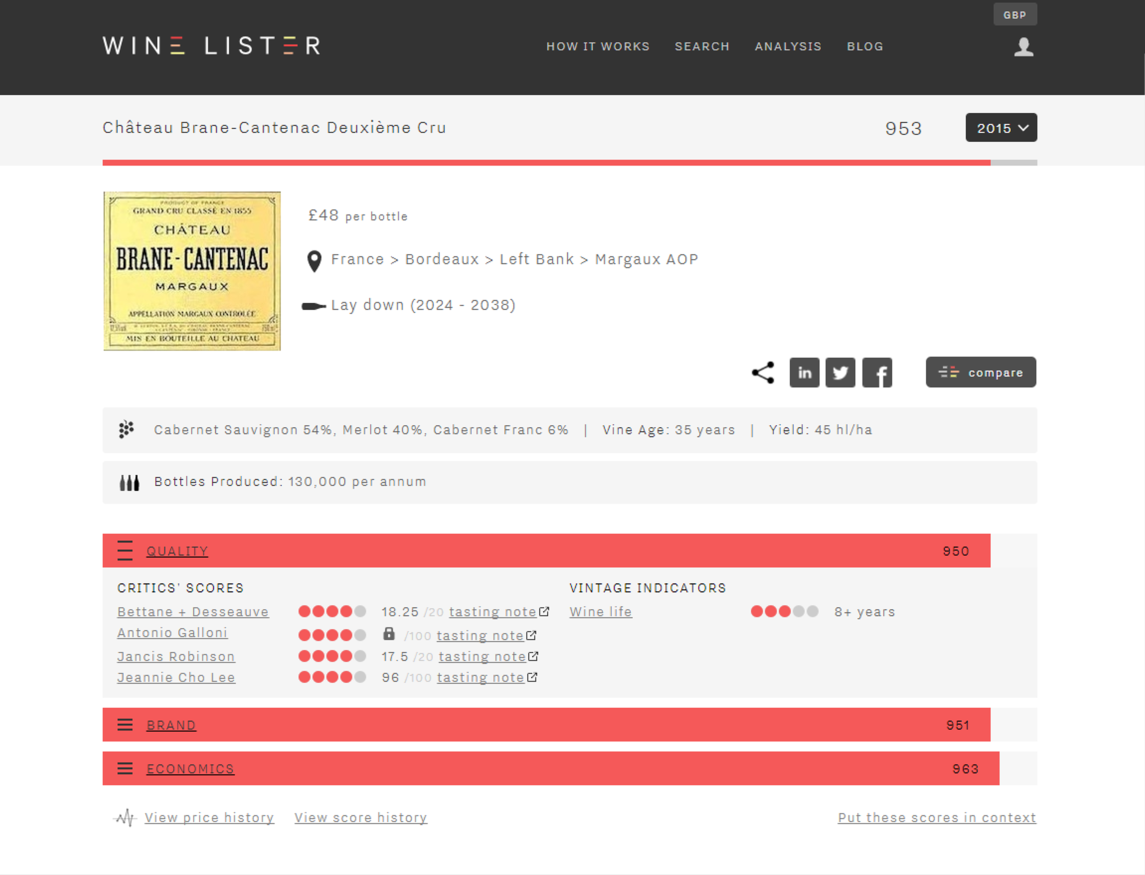
You may notice that some scores have changed for wines that have not been rated by Jeannie. In order to meet our goal of having the most comprehensive and up-to-date information, and the most rigorous rating algorithm, we have increased the sample set of scores upon which we carry out the normalisation between critics. This now includes the 18 months’ worth of new critic scores since our launch.












